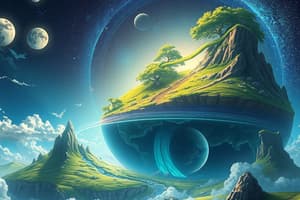Podcast
Questions and Answers
Which of the following is NOT one of Earth's subsystems?
Which of the following is NOT one of Earth's subsystems?
- Plasmasphere (correct)
- Lithosphere
- Atmosphere
- Biosphere
What percentage of the Earth's atmosphere is composed of oxygen?
What percentage of the Earth's atmosphere is composed of oxygen?
- 0.9%
- 3%
- 78%
- 21% (correct)
Which component of the Earth’s system is primarily responsible for thermal regulation?
Which component of the Earth’s system is primarily responsible for thermal regulation?
- Biosphere
- Hydrosphere (correct)
- Geosphere
- Atmosphere
Which of the following characteristics does NOT apply to minerals?
Which of the following characteristics does NOT apply to minerals?
The upper mantle of the Earth is characterized as being what?
The upper mantle of the Earth is characterized as being what?
Which of the following descriptions about the atmosphere is accurate?
Which of the following descriptions about the atmosphere is accurate?
What portion of Earth's fresh water is found in the form of ice?
What portion of Earth's fresh water is found in the form of ice?
The core of the Earth consists mainly of which two elements?
The core of the Earth consists mainly of which two elements?
What property of a mineral is described by the quality and intensity of reflected light?
What property of a mineral is described by the quality and intensity of reflected light?
Which scale is used to measure the resistance of a mineral to abrasion?
Which scale is used to measure the resistance of a mineral to abrasion?
Why is streak a better diagnostic property than color for identifying minerals?
Why is streak a better diagnostic property than color for identifying minerals?
What describes the geometric appearance of a crystal?
What describes the geometric appearance of a crystal?
What is the result of cleavage in minerals?
What is the result of cleavage in minerals?
Which term refers to minerals that have no distinct crystal form?
Which term refers to minerals that have no distinct crystal form?
Which of the following is true about hardness as measured by Mohs' Scale?
Which of the following is true about hardness as measured by Mohs' Scale?
When two minerals have different colors but the same streak, what does that indicate?
When two minerals have different colors but the same streak, what does that indicate?
Flashcards are hidden until you start studying
Study Notes
Earth's Subsystems
- Earth consists of four interconnected subsystems: biosphere, atmosphere, hydrosphere, and geosphere.
- The subsystems are in constant interaction, with matter and energy flowing across their boundaries.
Biosphere
- Encompasses all living organisms and the abiotic factors they depend on for energy and nutrients.
- Extends from the lower atmosphere to the deep sea vents of the ocean.
Atmosphere
- Thin layer of gases surrounding Earth.
- Composed primarily of nitrogen (78%), oxygen (21%), and a smaller percentage of other gases.
- Atmospheric circulation redistributes heat from the Equator to the poles.
Hydrosphere
- Includes all water on Earth's surface, including oceans, lakes, rivers, groundwater, and ice.
- 70% of Earth's surface is covered in water.
- Only 3% of the water is freshwater, with 2/3 frozen in ice and 1/3 in streams, lakes, and groundwater.
- Plays a vital role in regulating and redistributing heat on the planet.
Ocean Circulation
- Large-scale movement of water in ocean basins.
- Transports heat from warmer to cooler regions of the Earth.
Geosphere
- Earth's solid surface, including rocks, minerals, landforms, and the processes that shape the Earth's surface.
- Includes the crust, mantle, and core.
Mantle
- The thickest layer of the Earth.
- Divided into the upper mantle (less dense, brittle) and the lower mantle (denser, more plastic).
Lithosphere
- Solid, outermost layer of Earth.
- Made up of the upper mantle and the crust.
Asthenosphere
- Part of the upper mantle.
- Highly viscous and mechanically weak, allowing it to flow slowly.
Core
- The Earth's innermost layer.
- Composed primarily of iron and a small amount of nickel.
- Divided into the inner core (solid) and the outer core (liquid).
- The liquid iron in the core generates Earth's magnetic field.
Minerals
- Naturally occurring, solid, inorganic substances with a defined chemical composition and crystal structure.
Mineral Properties
- Luster: The way a mineral reflects light (metallic or non-metallic).
- Hardness: A mineral's resistance to scratching.
- Streak: The color of a mineral's powder.
- Crystal Form/Habit: The geometric shape of a mineral's crystal.
- Cleavage: The tendency of a mineral to break along smooth, flat surfaces.
- Fracture: The way a mineral breaks unevenly.
Studying That Suits You
Use AI to generate personalized quizzes and flashcards to suit your learning preferences.




